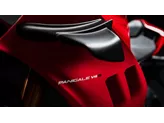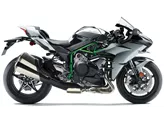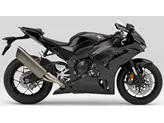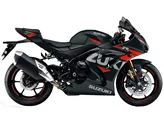Kawasaki Ninja ZX-10R 2016 vs. BMW S 1000 RR 2015

Kawasaki Ninja ZX-10R 2016

BMW S 1000 RR 2015
Visão geral - Kawasaki Ninja ZX-10R 2016 vs BMW S 1000 RR 2015
The Kawasaki Ninja ZX-10R 2016 and the BMW S 1000 RR 2015 are both supersport motorcycles that offer high performance and advanced technology.
In terms of their technical specifications, both motorcycles have an inline engine with four cylinders and a displacement of around 1000cc. The Kawasaki Ninja ZX-10R has a slightly smaller bore and stroke compared to the BMW S 1000 RR, but it compensates with a higher horsepower of 200.1 HP compared to the BMW's 199 HP. Both motorcycles have a high compression ratio of 13, indicating their performance-oriented nature.
In terms of suspension, both motorcycles feature a telescopic front fork and a swingarm rear suspension. The chassis of both motorcycles is made of aluminum, which provides a good balance between strength and weight.

Kawasaki Ninja ZX-10R 2016
When it comes to braking, both motorcycles are equipped with dual disc brakes at the front. The Kawasaki Ninja ZX-10R features radial petal technology, which provides excellent braking performance. The BMW S 1000 RR also has radial brakes, which offer precise and powerful stopping power.
In terms of dimensions and weights, both motorcycles have similar tire widths and diameters. The BMW S 1000 RR has a slightly longer wheelbase of 1425mm compared to the Kawasaki's 1415mm. The seat height of the BMW is also slightly higher at 815mm compared to the Kawasaki's 813mm. Both motorcycles have a fuel capacity of around 17 liters.

BMW S 1000 RR 2015
In terms of strengths, the Kawasaki Ninja ZX-10R 2016 is praised for its excellent chassis geometry, high-quality chassis components, excellent brakes, and a wide range of electronic features. On the other hand, the BMW S 1000 RR 2015 is praised for its excellent quickshifter, incredibly powerful and rev-happy engine, wide range of accessories, and the availability of data logging and race calibration tools.
However, both motorcycles have their weaknesses. The Kawasaki Ninja ZX-10R's cockpit is not perfectly legible, which may be a drawback for some riders. The BMW S 1000 RR's chassis can quickly reach its limits in the hands of professional riders, which may limit its performance potential in racing scenarios.
In conclusion, both the Kawasaki Ninja ZX-10R 2016 and the BMW S 1000 RR 2015 are high-performance supersport motorcycles with their own strengths and weaknesses. The Kawasaki offers excellent chassis geometry and high-quality components, while the BMW impresses with its powerful engine and range of accessories. Ultimately, the choice between the two will depend on the rider's preferences and priorities.
Especificações técnicas Kawasaki Ninja ZX-10R 2016 em comparação com BMW S 1000 RR 2015
Prós e contras em comparação
Prós e contras em comparação
Kawasaki Ninja ZX-10R 2016

A ZX-10R Ninja tem uma certa majestade, ao primeiro arranque parece muito estável, é preciso forçá-la um pouco no raio. Após algumas voltas, no entanto, este efeito transforma-se numa precisão incrível que permite uma linha precisa. O motor tornou-se agora visivelmente mais forte e faz da Kawa um pacote geral extremamente bom que pode agradar não apenas aos fãs obstinados da Kawasaki. O controle de tração no Kawa é particularmente positivo e regula muito sensivelmente. Até se pode ajustar o travão motor - por isso, não faltam certamente características electrónicas. A ZX-10R é a única superbike que já está em conformidade com a norma Euro4 em 2016!
BMW S 1000 RR 2015

A BMW ainda pode marcar pontos com factos concretos em 2015. Se gosta de desempenho de topo, tem de comprar o BMW. Torna-se incrivelmente poderoso no topo e afasta o resto do campo de 200. Os pilotos grandes e pesados poderão se beneficiar ainda mais disso. A BMW não facilitou as coisas para si mesma com esta moto e montou uma moto muito universal. Se fizéssemos um teste comparativo com 50 pilotos diferentes (desde principiantes a profissionais), a BMW teria a melhor média de todas as motos de 1000cc. O chassis eletrónico, mas também as ajudas à condução, tornam os profissionais rápidos e os principiantes seguros na estrada. Uma recomendação de topo para um grupo-alvo muito vasto. Os condutores amadores muito rápidos não ficarão 100% satisfeitos com a suspensão de série. Se não quiser modificar o chassis, deve optar por uma R1M, uma Panigale S ou uma RSV RF. Se quiser converter de qualquer forma, a S 1000 RR é a base mais forte e universal. Surpreendentemente, a potente máquina também anda muito bem em estradas rurais. Em suma, parece um compromisso, mas nunca se sente como tal na prática.
Comparação de preços Preço médio de mercado Kawasaki Ninja ZX-10R vs BMW S 1000 RR
There are a few key differences between a Kawasaki Ninja ZX-10R 2016 and a BMW S 1000 RR 2015. In terms of price, the actual average price of a Kawasaki Ninja ZX-10R 2016 is about 38% higher. A Kawasaki Ninja ZX-10R 2016 experiences a loss of 11.040 BRL in one year and 10.760 BRL in two years of ownership. This is offset by a loss of 10.470 BRL and 5.660 BRL for a BMW S 1000 RR 2015. Compared to BMW S 1000 RR 2015 there are less Kawasaki Ninja ZX-10R 2016 bikes available on the 1000PS.de Marketplace, specifically 4 compared to 8. It takes less time to sell a BMW S 1000 RR with 77 days compared to 100 days for the Kawasaki Ninja ZX-10R. Since model year 2005 1000PS.de editors have written 51 reviews for the Kawasaki Ninja ZX-10R and 135 reviews for the BMW S 1000 RR since model year 2010. The first review for the Kawasaki Ninja ZX-10R was published on 11/01/2004 and now has more than 2.900 views. This compares to more than 4.000 views for the first review on BMW S 1000 RR published on 16/04/2008.

















